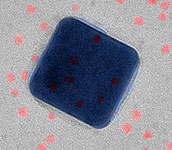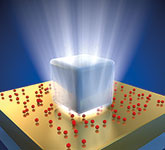Plasmonic device holds promise for super-fast computing
14 October 2015
Opto-Electronics
Electronics Technology
In a promising discovery towards the realisation of high-speed optical computing, researchers from Duke University’s Pratt School of Engineering have developed an ultrafast light-emitting device that can flip on and off 90 billion times a second.
A nanoscale view of the new superfast fluorescent system using a transmission electron microscope. The silver cube is just 75 nm wide. The quantum dots (red) are sandwiched between the silver cube and a thin gold foil.
Although lasers can switch this fast, they are too energy-hungry and unwieldy to integrate into computer chips. This new research has taken a different approach, by pushing semiconductor quantum dots to emit light at more than 90 GHz. This so-called plasmonic device could one day be used in optical computing chips or for optical communication between traditional electronic microchips.
The new speed record was set using plasmonics. When a laser shines on the surface of a silver cube just 75 nanometres wide, the free electrons on its surface begin to oscillate together in a wave. These oscillations create their own light, which reacts again with the free electrons. Energy trapped on the surface of the nanocube in this fashion is called a plasmon.
An illustration showing the silver nanocube sitting on top of a thin gold foil, with red quantum dots sandwiched between.
The plasmon creates an intense electromagnetic field between the silver nanocube and a thin sheet of gold placed a mere 20 atoms away. This field interacts with quantum dots – spheres of semiconducting material just 6 nm wide – that are sandwiched in between the nanocube and the gold. The quantum dots, in turn, produce a directional, efficient emission of photons that can be turned on and off at more than 90 GHz.
The group is now working to use the plasmonic structure to create a single photon source – a necessity for extremely secure quantum communications – by sandwiching a single quantum dot in the gap between the silver nanocube and gold foil. They are also trying to precisely place and orient the quantum dots to create the fastest fluorescence rates possible.
Aside from its potential technological impacts, the research demonstrates that well-known materials need not be limited by their intrinsic properties.
Further reading:
Versatile range of camera modules
EBV Electrolink
Opto-Electronics
The CAM-66GY pro-modules from ST are a full range of sample camera modules made for a seamless evaluation and integration of the VD66GY 1,5-megapixel colour image sensor.
Read more...
Enhanced breaker status and communication module
Schneider Electric South Africa
Opto-Electronics
Schneider Electric has announced the launch of its new Breaker Status and Communication Module (BSCM) Modbus SL/ULP, which delivers enhanced performance, improved connectivity, and simplified integration for power distribution systems.
Read more...
Heat-resistant LEDs
Opto-Electronics
Würth Elektronik’s new RGB LEDs are characterised by excellent heat resistance with an insensitivity to temperatures from -40 to 100°C making them ideal solutions for reliable, colour-variable lighting in applications at high operating temperatures.
Read more...
PhotoMOS relays
Future Electronics
Opto-Electronics
The AQY221R2SX and AQY221R2S PhotoMOS from Panasonic Industry ensures excellent characteristics and high-speed switching performance.
Read more...
Mouser now shipping onsemi’s image sensors
TRX Electronics
Opto-Electronics
The AR0145CS is a 1/4,3-inch CMOS digital image sensor with a 1280 (H) x 800 (V) active-pixel array that can capture both continuous video and single frames.
Read more...
Adaptive optics’ power solution
Altron Arrow
Opto-Electronics
Vicor power-dense adaptive optical modules enable colossal telescopes to look into the past for deep space discoveries.
Read more...
Ultra-high speed photo detection
Opto-Electronics
TDK Corporation has announced a photo-spintronic conversion element combining optical, electronic, and magnetic elements that can respond at an ultra-high speed of 20 picoseconds.
Read more...
High-speed lasers
RFiber Solutions
Opto-Electronics
Macom are a high-volume manufacturer of lasers, deploying more than 100 million devices with a reliability of less than 50 FIT and greater than 100 years of wear-out lifetime
Read more...
High-performance optical interconnect
Opto-Electronics
STMicroelectronics has unveiled its next generation of proprietary technologies for higher-performing optical interconnect in datacentres and AI clusters.
Read more...
Halo mid-board optical transceiver
Spectrum Concepts
Opto-Electronics
The Samtec Halo mid-board transceiver has been designed for next-generation embedded applications that require 56 and 112 Gbps PAM4 performance in low profile and ruggedised form factors.
Read more...



